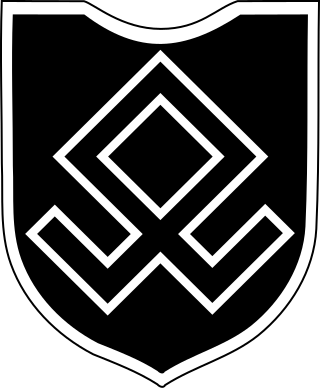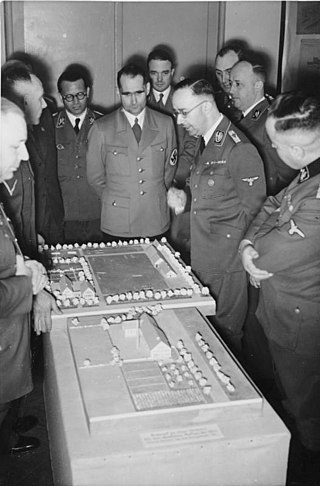Related Research Articles

In Nazi German terminology, Volksdeutsche were "people whose language and culture had German origins but who did not hold German citizenship". The term is the nominalised plural of volksdeutsch, with Volksdeutsche denoting a singular female, and Volksdeutscher, a singular male. The words Volk and völkisch conveyed the meanings of "folk".

The Heim ins Reich was a foreign policy pursued by Adolf Hitler before and during World War II, beginning in 1938. The aim of Hitler's initiative was to convince all Volksdeutsche who were living outside Nazi Germany that they should strive to bring these regions "home" into Greater Germany, but also relocate from territories that were not under German control, following the conquest of Poland, in accordance with the Nazi–Soviet pact. The Heim ins Reich manifesto targeted areas ceded in Versailles to the newly reborn state of Poland, various lands of immigration, as well as other areas that were inhabited by significant ethnic German populations, such as the Sudetenland, Danzig, and the southeastern and northeastern regions of Europe after 6 October 1939.

The Danube Swabians is a collective term for the ethnic German-speaking population who lived in Kingdom of Hungary of east-central Europe, especially in the Danube River valley, first in the 12th century, and in greater numbers in the 17th and 18th centuries. Most were descended from earlier 18th-century Swabian settlers from Upper Swabia, the Swabian Jura, northern Lake Constance, the upper Danube, the Swabian-Franconian Forest, the Southern Black Forest and the Principality of Fürstenberg, followed by Hessians, Bavarians, Franconians and Lorrainers recruited by Austria to repopulate the area and restore agriculture after the expulsion of the Ottoman Empire. They were able to keep their language and religion and initially developed strongly German communities in the region with German folklore.

The 7th SS Volunteer Mountain Division "Prinz Eugen", initially named the SS-Volunteer Division Prinz Eugen, was a mountain infantry division of the Waffen-SS, an armed branch of the German Nazi Party that served alongside but was never formally part of the Wehrmacht during World War II. At the post-war Nuremberg trials, the Waffen-SS was declared to be a criminal organisation due to its major involvement in war crimes and crimes against humanity. From 1942 to 1945, the division fought a counter-insurgency campaign against communist-led Yugoslav Partisan resistance forces in occupied Yugoslavia. It was formed in 1941 from both Reich Germans and Volksdeutsche – ethnic German volunteers and conscripts from the Banat, Independent State of Croatia, Hungary and Romania. The division surrendered on 11 May 1945 to Yugoslav Partisan forces.

Werner Lorenz was an SS functionary during the Nazi era. He was head of the Volksdeutsche Mittelstelle (VOMI), an organization charged with resettling ethnic Germans in the "German Reich" from other parts of Europe, as well as colonising the occupied lands during World War II. After the war, Lorenz was sentenced to prison for crimes against humanity in 1948. He was released in 1954 and died in 1974.
The Crimea Germans were ethnic German settlers who were invited to settle in the Crimea as part of the Ostsiedlung.

The Banat was a political entity established in 1941 after the occupation and partition of Yugoslavia by the Axis Powers in the historical Banat region. It was formally under the control of the German puppet Government of National Salvation in Belgrade, which theoretically had limited jurisdiction over all of the Territory of the Military Commander in Serbia, but all power within the Banat was in the hands of the local minority of ethnic Germans (Volksdeutsche). The regional civilian commissioner and head of the ethnic German minority was Josef Lapp. Following the ousting of Axis forces in 1944, this German-ruled region was dissolved and most of its territory was included into Vojvodina, one of the two autonomous provinces of Serbia within the new SFR Yugoslavia.

Prnjavor is a town and municipality in Republika Srpska, Bosnia and Herzegovina. According to the 2013 census, the town has a population of 8,120 inhabitants, with 35,956 inhabitants in the municipality.

The Germans of Yugoslavia is a term for German-speakers who form a minority group in former Yugoslavia, namely Croatia, Serbia, Bosnia and Herzegovina or Slovenia. Despite the name for the group, the label includes ethnic Germans, primarily Danube Swabians, and Austrians. The largest German minority was found in Serbia prior to dissolution of Yugoslavia.

Nova Pazova is a settlement in Serbia. It is situated in the Stara Pazova municipality, in the region of Syrmia, in the autonomous province of Vojvodina. The settlement's population is currently 17,105.

Glogonj is a village in Serbia, situated in the South Banat District of the province of Vojvodina. It is located on the banks of the Tamiš River, about 20 kilometers northwest of Pančevo, and about 20 kilometers direct north of Belgrade. It has a Serb ethnic majority, numbering 2,657 people as of 2022. Its neighboring villages are Sefkerin to the north and Jabuka to the south. All of them lie on the Tamiš.

In Nazi Germany the Volksdeutsche Mittelstelle or VoMi was a Nazi Party agency founded to manage the interests of the Volksdeutsche - the population of ethnic Germans living outside the Third Reich. Ultimately coming under Allgemeine-SS administration, it became responsible for orchestrating the implementation of Nazi Lebensraum policies in Eastern Europe during World War II.
The Germans of Serbia are an ethnic minority of Serbia which numbers 4,064 people according to last population census from 2011. The Germans of Serbia usually refer to themselves as Swabian, and they are grouped into the Danube Swabians or Banat Swabians in the Vojvodina region, where the majority of the population resides. Germans settled parts of Serbia in the late 17th century during Habsburg administration. The German population of Vojvodina was more numerous in the past. More than 250,000 left during the withdrawal of Nazi forces. As a consequence of the World War II events in Yugoslavia, the Yugoslav Communist government took a reprisals on ethnic citizens of German origin in Yugoslavia : they had their citizenship revoked and their belongings and houses were nationalized and taken from them. Between 1944 and 1946, a prison camp system was established for Yugoslav citizens of German origin, usually in settlements where they lived. After prison camps were abolished, ethnic Germans of Yugoslavia regained their rights and citizenship and most of them emigrated to Germany or Austria in the following years because of economic reasons.

Erhard Kroeger or Kröger was a Baltic German SS officer involved in the resettlement of Baltic Germans before World War II. He commanded an Einsatzgruppe in 1941, and was later attached to General Andrey Vlasov and the German sponsored Russian Liberation Army of World War II. He was convicted of war crimes in 1969.

Nova Topola is a village in the municipality of Gradiška, Republika Srpska, Bosnia and Herzegovina. Nova Topola has a population of 2,324 inhabitants. It was founded by German settlers.

Josef "Sepp" Janko was a Volksgruppenführer of the Danube Swabian German Cultural Association in Yugoslavia in 1939, and later was appointed SS Obersturmführer during World War II.

Branimir Altgayer was a German minority leader in the Kingdom of Yugoslavia and the Independent State of Croatia, and an SS officer in World War II.
Franzjosefsfeld was a German language Danube Swabian settlement in northern Bosnia.

Hermann Johann Heinrich Behrends was a Nazi Party member and SS official with the rank of lieutenant general (Gruppenführer).

During World War II, several provinces of the Kingdom of Yugoslavia corresponding to the modern-day state of Serbia were occupied by the Axis Powers from 1941 to 1944. Most of the area was occupied by the Wehrmacht and was organized as separate territory under control of the German Military Administration in Serbia. Other parts of modern Serbia that were not included in the German-administered territory were occupied and annexed by neighboring Axis countries: Syrmia was occupied and annexed by the Independent State of Croatia, Bačka was occupied and annexed by Hungary, southeastern Serbia was occupied and annexed by Bulgaria, and southwestern Serbia was occupied and annexed by Italy and included in the Italian protectorates of Albania and Montenegro.
References
- ↑ Henry A. Fischer Schutzberg (Glogovac) in Bosnia Danube Swabian Resources
- ↑ "Regionalseiten offline".
- ↑ Philipp Weingartner A Journey of Faith Across a Turbulent Century: Memoirs of a Refugee Pastor FriesenPress, Dec 4, 2020 - Biography & Autobiography - 401 pages ISBN 1525589873 ISBN 9781525589874
- ↑ Valdis O. Lumans, Himmler's Auxiliaries: The Volksdeutsche Mittelstelle and the German Minorities of Europe, 1939-1945 (1993)
- ↑ "Regionalseiten offline".